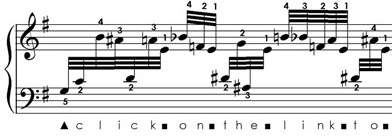Just now it occurred to me to put my hands over the electric piano keyboard and mentally touch-type. Kind of a cool experience – the music sounds clearly like some kind of communication, but not necessarily typing – it reminded me a little of the violent outbursts of birdsong in Messiaen’s Catalogue d’Oiseaux.
Click on the link to hear an MP3 of me typing this very sentence on the piano.
Here’s how the first part of the score would look. My touch-type fingering is slightly idiosyncractic, I’m led to understand. Naturally, the sentence is in E minor, the key of the space bar. The triangle is shift, the square is space. Obviously.
I didn’t dare try to really notate the rhythms, which have an interesting natural edge to them. That skittering quality is in some 20th-century music, but it really doesn’t lend itself to our rhythmic notation and it always strikes me as silly when a piece looks like outrageous poly-subdivided-tuplet-opia on the page but actually just sounds…you know, skittish. Only the very best performances of such pieces come anywhere near the actual sincere skitt of typing. It was sort of interesting to realize that I could instantly produce endless quantities of that dry spidery stuff through as simple a trick as imagining the piano to be a typewriter.
This reminds me of my occasional fascination with the distinctly childlike nature of certain rushed rhythms. Playing Heart and Soul like an 8-year-old intentionally is hard to get right. 8-year-olds – American 8-year-olds, at least – have access to a truly profound freedom from meter that’s very tricky to fake.
Anyway.
I have to assume this typewriter thing has been done before. I don’t think there’s much you can do with it. I imagine it would have interested John Cage-y types back in the late 60s, when automatic and unspecified music was a big thing. Here, I’ll make up a terrible experimental piece right now. Here’s the score (except imagine this inside a battered score published by Peters on an absolutely enormous scale, handwritten in the center of a big blank page in a very deliberate style).
CHAT ROOM FOR TWO PIANISTS (c) 2005
1. The pianos are arranged so that the performers are exactly back to back, unable to see one another. They only communicate through the pianos.
2. The pianists must be fluent typists. They are to place their hands over the piano keys and then type as though their hands were on QWERTY computer keyboards, hitting whatever piano keys their fingers find in the places where they seek the different letters. It is neither necessary nor desirable for the pianists to establish fixed correspondences between particular piano keys and imaginary QWERTY keys; they should simply follow their fingers.
3. The work consists of a conversation between the two pianists conducted only through typed messages. Each pianist listens to what is typed by the other and interprets it the best of his/her ability. It is essential that each pianist imagine that he/she is fully able to understand each message, and respond confidently.
4. The work begins with Piano 1 typing “any1 there? plz answer!” and hitting Enter.
5. Piano 2 then responds as he/she sees fit, and the conversation continues naturally.
6. If they so choose, the two pianists may confer in advance and plan a course for the conversation. They may do this either by simply deciding on topics to be discussed, or by establishing a dramatic outline for the work as a whole (i.e. pre-planning periods of argument, flirtation, etc.) It is permissible, though not encouraged, for the performers to script “lines” in advance. However, the performers may not in any way prepare musical material.
7. The duration of the work is left to the discretion of the performers.
8. The work ends with Pianos 1 and 2 each typing “l8r :)” and hitting Enter in short succession.
